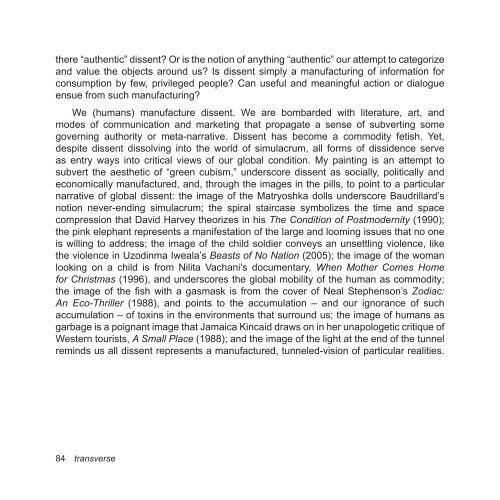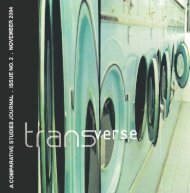Untitled - Centre for Comparative Literature - University of Toronto
Untitled - Centre for Comparative Literature - University of Toronto
Untitled - Centre for Comparative Literature - University of Toronto
Create successful ePaper yourself
Turn your PDF publications into a flip-book with our unique Google optimized e-Paper software.
there “authentic” dissent? Or is the notion <strong>of</strong> anything “authentic” our attempt to categorize<br />
and value the objects around us? Is dissent simply a manufacturing <strong>of</strong> in<strong>for</strong>mation <strong>for</strong><br />
consumption by few, privileged people? Can useful and meaningful action or dialogue<br />
ensue from such manufacturing?<br />
We (humans) manufacture dissent. We are bombarded with literature, art, and<br />
modes <strong>of</strong> communication and marketing that propagate a sense <strong>of</strong> subverting some<br />
governing authority or meta-narrative. Dissent has become a commodity fetish. Yet,<br />
despite dissent dissolving into the world <strong>of</strong> simulacrum, all <strong>for</strong>ms <strong>of</strong> dissidence serve<br />
as entry ways into critical views <strong>of</strong> our global condition. My painting is an attempt to<br />
subvert the aesthetic <strong>of</strong> “green cubism,” underscore dissent as socially, politically and<br />
economically manufactured, and, through the images in the pills, to point to a particular<br />
narrative <strong>of</strong> global dissent: the image <strong>of</strong> the Matryoshka dolls underscore Baudrillard’s<br />
notion never-ending simulacrum; the spiral staircase symbolizes the time and space<br />
compression that David Harvey theorizes in his The Condition <strong>of</strong> Postmodernity (1990);<br />
the pink elephant represents a manifestation <strong>of</strong> the large and looming issues that no one<br />
is willing to address; the image <strong>of</strong> the child soldier conveys an unsettling violence, like<br />
the violence in Uzodinma Iweala’s Beasts <strong>of</strong> No Nation (2005); the image <strong>of</strong> the woman<br />
looking on a child is from Nilita Vachani’s documentary, When Mother Comes Home<br />
<strong>for</strong> Christmas (1996), and underscores the global mobility <strong>of</strong> the human as commodity;<br />
the image <strong>of</strong> the fi sh with a gasmask is from the cover <strong>of</strong> Neal Stephenson’s Zodiac:<br />
An Eco-Thriller (1988), and points to the accumulation – and our ignorance <strong>of</strong> such<br />
accumulation – <strong>of</strong> toxins in the environments that surround us; the image <strong>of</strong> humans as<br />
garbage is a poignant image that Jamaica Kincaid draws on in her unapologetic critique <strong>of</strong><br />
Western tourists, A Small Place (1988); and the image <strong>of</strong> the light at the end <strong>of</strong> the tunnel<br />
reminds us all dissent represents a manufactured, tunneled-vision <strong>of</strong> particular realities.<br />
84 transverse




